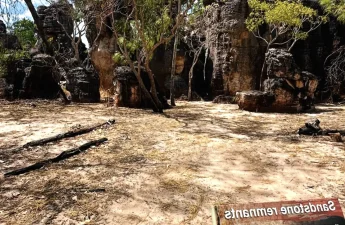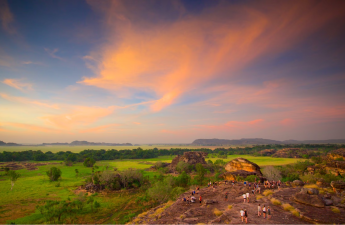Kakadu National Park, a premier destination for nature and culture enthusiasts, offers a plethora of activities that beckon the adventurous spirit. Set in the heart of Australia’s Northern Territory, this UNESCO World Heritage-listed site spans over 19,800 square kilometers, boasting a landscape as vast as it is diverse. From ancient Indigenous rock art sites to the wild beauty of its wetlands and waterfalls, Kakadu is a place where stories of the Earth’s past are etched into every view. This guide is designed to unlock the best things to do in Kakadu, ensuring that your journey – whether it be a 2 day Kakadu tour from Darwin or an extended adventure – is filled with unforgettable experiences.
Understanding Kakadu’s Cultural Significance

Kakadu National Park is not only a natural wonder but also a testament to the longstanding presence of Indigenous culture in the region. The park’s landscape serves as an intricate canvas showcasing the rich narrative of Aboriginal peoples that have lived here for over 65,000 years. Delving into this history is essential to appreciating the park’s spiritual significance.
Aboriginal Rock Art Galleries: Windows into an Ancient Past
As you navigate through the rugged terrains of Kakadu, the rock art galleries invite you to step back in time. Two significant sites, Ubirr and Nourlangie, present spellbinding depictions of ancestral beings, traditional ceremonies, and local wildlife. These galleries offer a unique opportunity to connect with the worldviews and customs of the park’s traditional owners.
The complex narratives told through the artwork at Ubirr and Nourlangie provide an intimate glimpse into Kakadu’s cultural tapestry. With each art piece steeped in lore and tradition, visitors gain a profound understanding of the park’s ancestry, which continues to be passed down through generations of the Bininj/Mungguy people.
Wildlife Encounters in their Natural Habitat
The diverse ecosystems within Kakadu are home to an array of wildlife, with the possibility of sightings ranging from the iconic saltwater crocodile to over 280 bird species. This natural paradise offers direct insight into Australia’s unique fauna and the intrinsically woven connections that sustain the park’s living networks.
Billabongs and Wetlands: A Birder’s Paradise
The tranquil waters of the park’s billabongs and floodplains create a perfect habitat for an impressive bird population. Kakadu’s wetlands serve as a vital breeding ground for many species, providing birdwatchers with ample viewing opportunities, especially during the early dry season.
For those keen on observing the park’s larger inhabitants, the Yellow Water Cruise is a must-do activity. As you meander along the waterways, keep an eye out for the basking crocodiles on the banks and the herds of water buffalo grazing in the marshes—an unparalleled wildlife encounter in their natural domain.
Landscapes Beyond Imagination
Kakadu’s geography is marked by contrasting landscapes, each with its majestic beauty. The Escarpment and Stone Country provide a rugged backdrop to the spectacular waterfalls plunging into deep pools below. A visit to these natural landmarks showcases the park’s dramatic geological formations and time-worn vistas.
The Escarpment and Stone Country: Rugged Beauty
Challenging yet rewarding, exploring the Escarpment and Stone Country will lift your spirits and test your endurance. Trekking across this terrain uncovers the sheer scale and untouched splendor of the park’s wilderness, illustrating why Kakadu has earned its place as a natural wonder.
Jim Jim Falls and Twin Falls are two of Kakadu’s most iconic attractions, epitomizing the park’s boundless beauty. These towering waterfalls are at their most spectacular after the wet season floods, cascading down cliffs into crystal-clear plunge pools, accessible by 4WD, boat, or short hikes.
Thrilling Outdoor Activities for the Bold
Kakadu is not just for the contemplative visitor; it also caters to those seeking adrenaline-boosting exploits. Whether it’s the thrill of navigating rugged terrain by 4WD or soaring above the vast landscape in a helicopter, adventure seekers will find plenty to satisfy their cravings.
4WD Adventures: Off the Beaten Track
Venturing off the main roads and into the heart of the bush delivers the quintessential Kakadu experience. The park’s challenging tracks demand a 4WD vehicle and a sense of adventure, rewarding those daring enough with secluded spots and less-visited vistas.
Kakadu by Air: Helicopter Tours for a Bird’s Eye View
There’s no more striking perspective of Kakadu’s vastness than from the sky. Helicopter tours provide an unparalleled overview of the park, taking in landmarks and landscapes that are often inaccessible by land—making for an exhilarating and memorable journey.
Participate in Ranger-Guided Tours and Cultural Activities
Ranger-guided tours and cultural programs are at the heart of the Kakadu experience, providing essential context and insight into the park’s heritage and ecosystems. These activities allow visitors to engage with the area in a respectful and enlightening way, deepening their appreciation for Kakadu’s ancient traditions.
Learn from the Traditional Custodians
Partaking in activities led by Indigenous rangers offers a rare chance to hear stories directly from the traditional custodians of the land. Visitors can learn about Indigenous art, bush tucker, and the deep spiritual connection to the country—an enriching experience for all ages.
Bush Foods and Medicines: An Aboriginal Educational Experience
Discovering the practical uses of native plants for food and medicine affords a valuable perspective on Aboriginal survival and resourcefulness. This interactive engagement challenges perceptions and showcases sustainable practices that have thrived for millennia.
When to Visit Kakadu for the Best Experience
Timing is crucial when planning a trip to Kakadu, as the park undergoes a profound transformation with the changing seasons. Understanding the best time to visit ensures that you can enjoy the park’s offerings to their fullest, from lush wetlands to the vibrant cultural events that intersperse the calendar year.
Seasonal Insights: Navigating Kakadu’s Changing Landscapes
The unique climates of Kakadu, known as the ‘Gudjewg’ monsoon season and the ‘Banggerreng’ knock ’em down storm season, among others, influence when and how the park can be accessed. Floodwaters breathe life into the land, while the dry periods expose routes to hidden corners of the park that are submerged at other times.
Fishing Seasons and Cultural Festivities: Timing Your Trip
| Season | Experience |
|---|---|
| Wet Season (Nov-Mar) | Powerful waterfalls and lush wetlands; some areas may be less accessible due to flooding. |
| Dry Season (Apr-Oct) | Prime time for wildlife spotting, hiking, and attending cultural festivals. |
Kakadu’s seasonal changes not only dictate the natural scenery but also the range of cultural activities available to visitors. Planning your visit according to these seasons can ensure that you experience the best that the park has to offer, be it the thrill of the catch during the Barramundi fishing season or the joy of a cultural celebration.
Conclusion
Kakadu National Park is an extraordinary accumulation of natural beauty, cultural heritage, and adventure activities. The park presents a canvas where ancient art and stories adorn the rocks, wildlife thrives in abundance, and dramatic landscapes take your breath away. Whether you opt for a 2 day Kakadu tour from Darwin or plan an extended exploration, each moment spent in this remarkable wild space will leave a lasting imprint on your heart. Kakadu is indeed a place where every journey is an epic tale waiting to unfold.
FAQs
Do I need a permit to enter Kakadu National Park?
Yes, visitors need a park pass, which can be purchased online or at various visitor centers in and around Kakadu National Park.
What is the best time of year to visit Kakadu for waterfalls?
The best time to see the waterfalls in full flow is during the wet season (November to March), although access may be limited due to flooding. The dry season (May to October) provides easier access and the opportunity to see the falls in a more tranquil state.
Are there any dangerous animals to be aware of in Kakadu?
Yes, Kakadu is home to saltwater crocodiles. It’s crucial to observe safety signs and keep a safe distance from waterways where crocodiles may be present.
Can I camp anywhere in Kakadu National Park?
No, camping is allowed only in designated camping areas within the park to ensure safety and protect the environment. It’s best to check the latest information on camping sites and their facilities before your trip.
How can I learn about the Indigenous culture of the area?
Kakadu offers a range of Aboriginal-led tours and cultural experiences where visitors can learn about the traditional owners’ history, culture, and connection to the land, offering a deeper understanding of the park’s significance.

